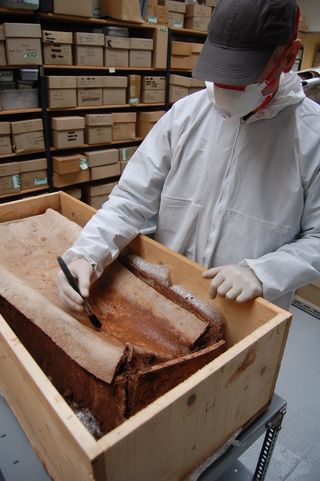Bone and Bracelets Found in Roman Child's Coffin

A group of archaeologists in England this week lifted the lid on a Roman child's coffin, discovering that it contains fragments of bones and two tiny bangles.
Last month, treasure hunters equipped with metal detectors led archaeologists to the rare lead coffin buried in a field in Warwickshire. The funerary box was child-sized, and researchers think it is likely more than 1,600 years old, dating back to the Roman occupation of Britain.
A crew with a group called Archaeology Warwickshire opened the coffin on Monday (Nov. 11) and found fragmentary skeletal remains and two bracelets made of jet, a dark black gemstone.
"Finding the two jet bangles was a surprise," Stuart Palmer, the business manager for Archaeology Warwickshire said in a statement. "They rather suggest that the child was female although we cannot say with certainty if they were worn as bracelets, clothing adornments or were woven into long hair."
Researchers took samples of the silt inside the coffin to investigate traces of the human remains and any other items that might have been inside, such as flowers, oils and clothing. The team says it might even be possible to detect evidence of ancient Roman medicines or drugs in chemical signatures in the samples.

"We will carefully sift through these over the coming weeks to recover as much as possible and determine if there is anything suitable for detailed analysis," Palmer said. "This will include the submission of a sample for a radiocarbon date, which we hope will narrow down the possible date range for the burial." (Radioactive carbon-14 is naturally occurring and decays at a predictable rate, giving scientists a way to determine the age of remains.)
Lead coffins are somewhat rare among burials in Britain. Earlier this year, when archaeologists lifted the lid on a stone coffin at the site of Richard III's rediscovered grave, they found another lead coffin inside. [In Photos: The Search for King Richard III's Grave]
Sign up for the Live Science daily newsletter now
Get the world’s most fascinating discoveries delivered straight to your inbox.
Though the child's name has been lost to history, Archaeology Warwickshire has appealed to the public to vote on a moniker for him or likely her. The group has chosen five possible names based on Roman words: Oriens (rise – as the sun), Loquor (tell- declare), Addo (inspire), Accendo (illuminate) and Parvulus (infant).
You can vote for your favorite here or tweet your choice to @OisintheDeer.
Follow Megan Gannon on Twitter and Google+. Follow us @livescience, Facebook & Google+. Original article on Live Science.

